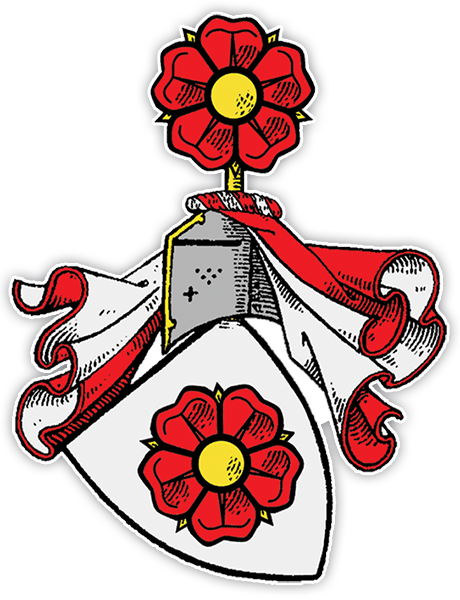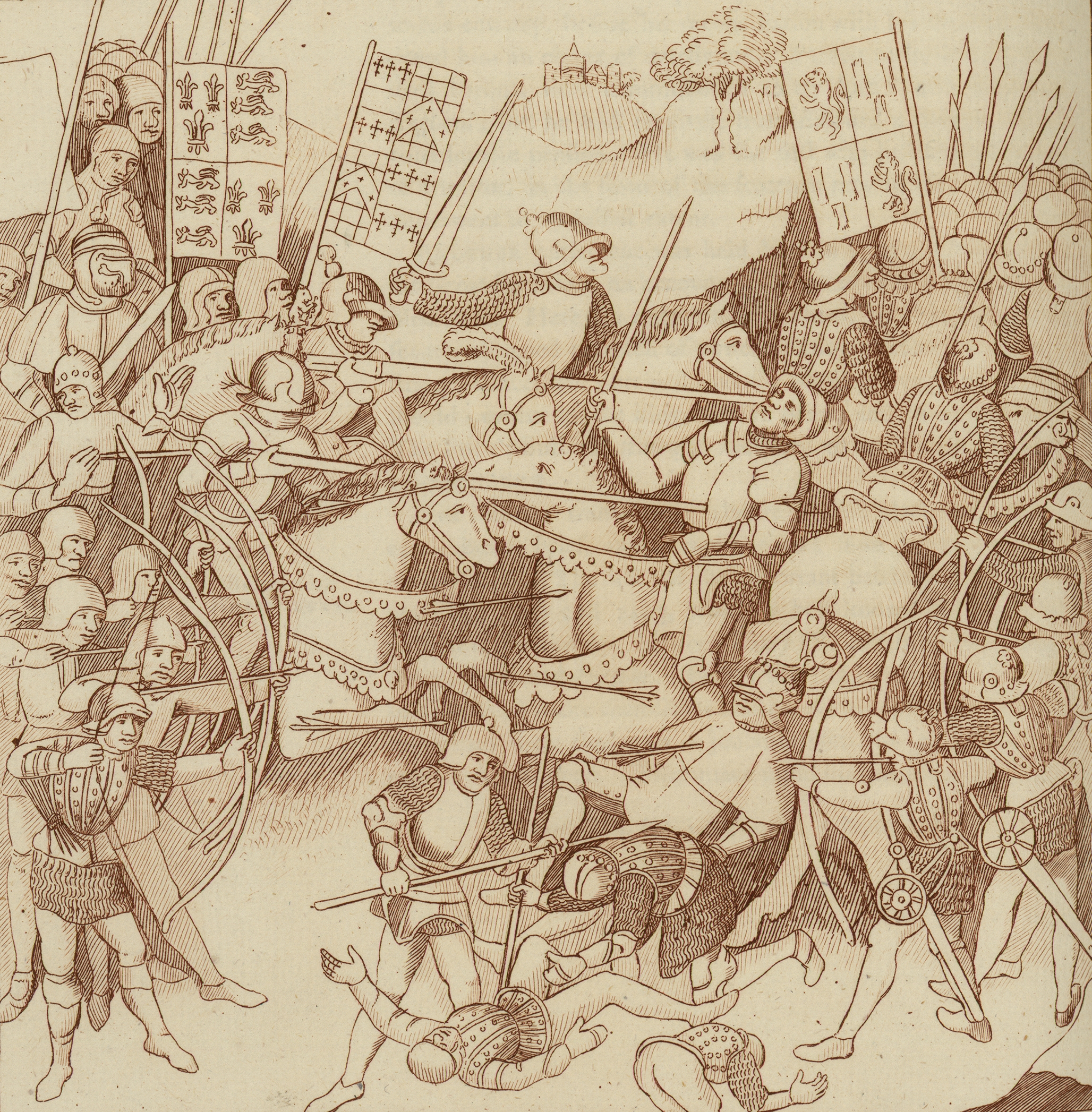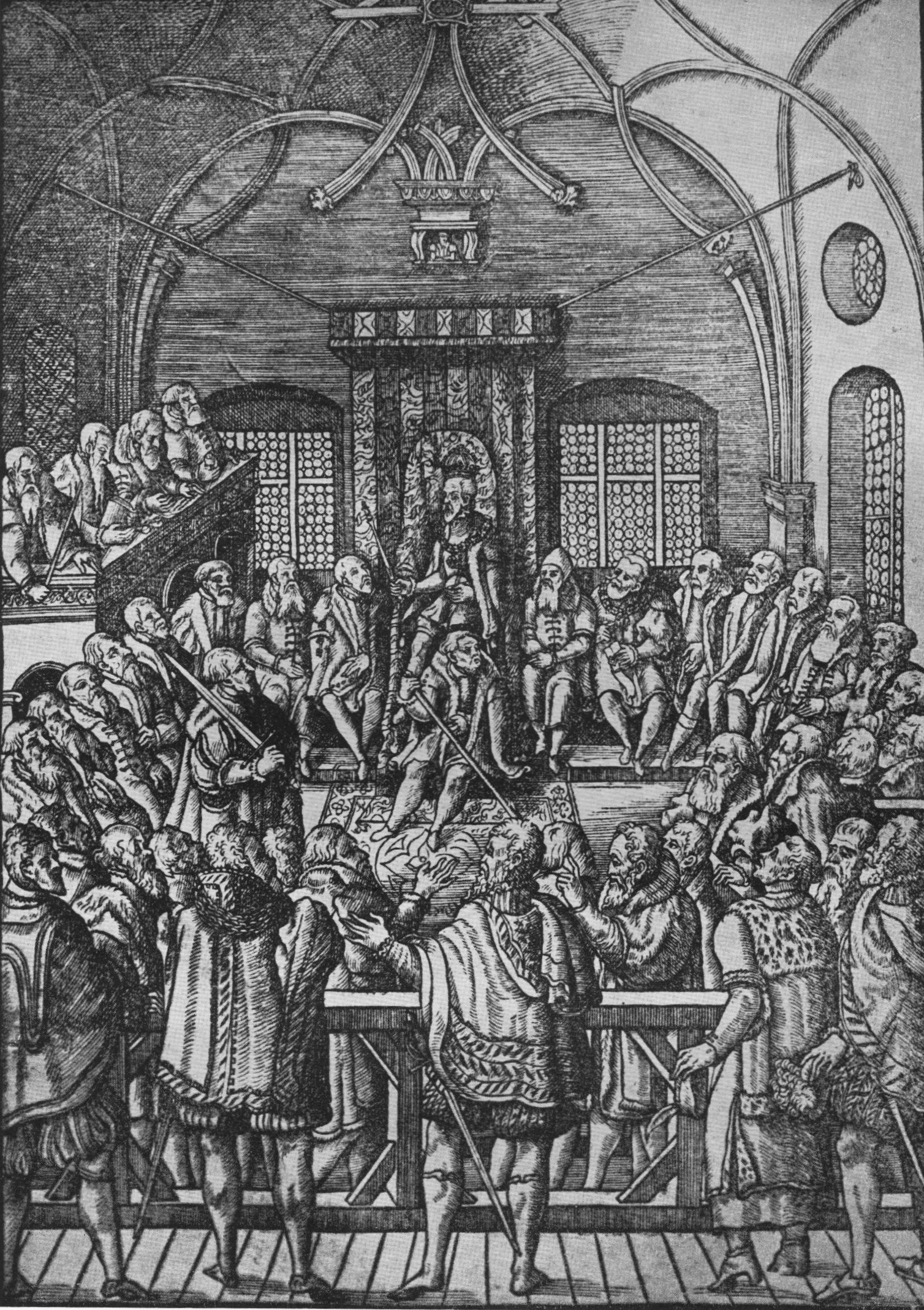|
Oldřich II Of Rosenberg
Oldřich II of Rosenberg (Czech: ; 13 January 1403 – 28 April 1462) was an important Bohemian nobleman who, after the Battle of Lipany, became a recognized leader of the Catholic lords in Bohemia. Biography Oldřich II increased the power of the Rosenberg family after taking advantage of the weakening royal power during the Hussite wars. Oldřich was initially sympathetic for the Hussite movement, a position influenced by his guardian Čeněk of Wartenberg. However, after the Hussites burned down the town of Sezimovo Ústí in 1420 and founded Tábor on the very northern border of the , Oldřich became a leading ally of Emperor Sigismund and acted as a negotiator and diplomat. Sigismund appointed him governor of the Bechyně region and Prácheňsko. Oldřich II was defeated in the Battle of Tábor and in the near modern-day Malý Bor, and participated in the Battle of Vyšehrad in 1420. He found later military success in the Battle of Lipany in 1434 and saw to the destruction ... [...More Info...] [...Related Items...] OR: [Wikipedia] [Google] [Baidu] |
Charles Louis Philippot
Charles Louis Philippot, also known as Karl Ludwig Philippot, (1 October 1801 - 31 December 1859) was a French artist who primarily worked in Český Krumlov. Philippot was born in Sainte-Menehould, France. In 1833, he set up a studio in Linz. He remained in Linz until 1839, when he became the Court Painter to Prince Schwarzenberg at Český Krumlov. During his service to the House of Schwarzenberg, he painted portraits of many prominent members of the Rosenberg family, Eggenberg family, and Schwarzenberg family. He also painted the altarpieces in the chapel of Český Krumlov Castle. He died in Český Krumlov on 31 December 1859. References External links 1801 births 1859 deaths French artists {{France-artist-stub ... [...More Info...] [...Related Items...] OR: [Wikipedia] [Google] [Baidu] |
Battle Of Tábor
The Battle of Tábor took place in the early morning hours of 30 June 1420 in a locality between and the Lužnice near the walls of a newly emerging Hussite village called Tábor. Between 3,000 and 9,000 Taborites, including women and children, remained in the village after a Hussite detachment left for Prague. Taking advantage of their weakened state, Oldřich II of Rosenberg laid siege to the village. He commanded a force composed of his own gunmen and Austrian mercenaries led by Lipolt Krajíř of Krajek, the governor of České Budějovice. Learning of the siege, Mikuláš of Hus Mikuláš of Hus ( ; died 24 December 1420) was a Bohemian politician and leading representative of the Hussite movement. He died unexpectedly on 24 December 1420, leaving the position of first captain of the Taborites open to Jan Žižka J ... left Prague with 350 cavalry and returned to Tábor. In the early morning of 30 June 1420, he attacked the sleeping besiegers. Oldřich II of Ro ... [...More Info...] [...Related Items...] OR: [Wikipedia] [Google] [Baidu] |
1462 Deaths
Year 1462 (Roman numerals, MCDLXII) was a common year starting on Friday of the Julian calendar. Events January–December * March 27 – Ivan III of Russia becomes the ruler of Russia, following the death of his father, Vasili II of Russia, Vasili. * June 17 – The Night Attack: Vlad III Dracula attempts to assassinate Mehmed II, forcing him to retreat from Wallachia. * June 30 – Battle of Seckenheim: Frederick I, Elector Palatine is victorious over four other opponents. * July 22 – The first siege of Kiliya, Chilia by Stephen the Great fails, and he is seriously wounded. * September 17 – Thirteen Years' War (1454–66), Thirteen Years' War – Battle of Świecino (Battle of Żarnowiec): The Kingdom of Poland (1385–1569), Kingdom of Poland defeats the Teutonic Order. * September – Siege of Mytilene (1462), Siege of Mytilene: Mehmed II captures the town of Mytilene, thus conquering the island of Lesbos. * December – After Ra ... [...More Info...] [...Related Items...] OR: [Wikipedia] [Google] [Baidu] |
1403 Births
Year 1403 ( MCDIII) was a common year starting on Monday of the Julian calendar. Events January–March * January 5 – In what is now Myanmar, peace negotiations begin between King Razadarit of Hanthawaddy at his capital Pegu, with the emissaries of Minkhaung I, ruler of the Kingdom of Ava, 10 days after the Ava forces defeated Razadarit's army at the Battle of Nawin.Yazawin Thit Vol. 1 2012: 220–221 * January 23 – The Yongle Era in China begins with the first day of the Chinese New Year, six months after King Zhu Di of the Yan State arrived at Nanjing, deposed the southern Chinese Emperor Zhu Yun Wen, and proclaimed himself as the Emperor Cheng Zu. * February 20 – Signing of the Treaty of Gallipoli is completed as Süleyman Çelebi makes wide-ranging concessions to the Byzantine Empire and other Christian powers, in the southern Balkans. * February 7 – King Henry IV of England marries as his second wife Joan of Navarre, the daughter of King ... [...More Info...] [...Related Items...] OR: [Wikipedia] [Google] [Baidu] |
Against All
"None of the above" (NOTA), or none for short, also known as "against all" or a "scratch" vote, is a ballot option in some jurisdictions or organizations, designed to allow the voter to indicate disapproval of the candidates in a voting system. It is based on the principle that consent requires the ability to withhold consent in an election, just as they can by voting "No" on ballot questions. It must be contrasted with "abstention", in which a voter does not cast a ballot. Entities that include "None of the Above" on ballots as standard procedure include Argentina, Belarus, Belgium, Bulgaria („Не подкрепям никого“, "I don't support anyone"), Colombia (), France (''vote blanc'', "blank vote"), Greece (, blank), India ("None of the above"), Indonesia (, "empty box"), Kazakhstan, Mongolia, the Netherlands, North Korea, Norway, Peru, Spain (, "blank vote"), Uruguay, and the U.S. state of Nevada (None of These Candidates). Russia had such an option on its bal ... [...More Info...] [...Related Items...] OR: [Wikipedia] [Google] [Baidu] |
Order Of The Dragon
The Order of the Dragon (, literally "Society of the Dragonists") was a Chivalric order#Monarchical or dynastical orders, monarchical chivalric order only for selected higher aristocracy and monarchs,Florescu and McNally, ''Dracula, Prince of Many Faces''. pp. 40–2. founded in 1408 by Sigismund, Holy Roman Emperor, Sigismund of Luxembourg, who was then King of Hungary and King of Croatia, Croatia (r. 1387–1437) and later also Holy Roman Emperor (r. 1433–1437). It was fashioned after the military order (monastic society), military orders of the Crusades, requiring its initiates to defend the Christian cross, cross and fight the enemies of Christianity, particularly the Ottoman Empire. The Order flourished during the first half of the 15th century, primarily in Germany and Italy. After Sigismund's death in 1437, its importance declined in Western Europe. However, after the Fall of Constantinople in 1453, it continued to play a role in Hungary, Serbia and Romania, which bore ... [...More Info...] [...Related Items...] OR: [Wikipedia] [Google] [Baidu] |
Orsini Family
The House of Orsini is an Nobility of Italy, Italian noble family that was one of the most influential princely families in Middle Ages, medieval Italy and Renaissance Rome. Members of the Orsini family include five popes: Pope Stephen II, Stephen II (752–757), Pope Paul I, Paul I (757–767), Pope Celestine III, Celestine III (1191–1198), Pope Nicholas III, Nicholas III (1277–1280), and Pope Benedict XIII, Benedict XIII (1724–1730). The family also included 34 Cardinal (Catholic Church), cardinals, numerous ''condottieri'', and other significant political and religious figures. The Orsini are part of the Black nobility who were Roman aristocratic families who supported the Popes in the governance of the Papal States. Origins According to their own family legend, the Orsini are descended from the Julio-Claudian dynasty of ancient Rome. The Orsini carried on a political feud with the Colonna family for centuries in Rome, until it was stopped by Papal Bull in 1511. In 1571 ... [...More Info...] [...Related Items...] OR: [Wikipedia] [Google] [Baidu] |
Roman People
The Roman people was the ethnicity and the body of Roman citizens (; ) during the Roman Kingdom, the Roman Republic, and the Roman Empire. This concept underwent considerable changes throughout the long history of the Roman civilisation, as its borders expanded and contracted. Originally only including the Latins of Rome itself, Roman citizenship was extended to the rest of the Italic peoples by the 1st century BC and to nearly every subject of the Roman empire in late antiquity. At their peak, the Romans ruled large parts of Europe, the Near East, and North Africa through conquests made during the Roman Republic and the subsequent Roman Empire. Although defined primarily as a citizenship, "Roman-ness" has also and variously been described as a cultural identity, a nationality, or a multi-ethnicity that eventually encompassed a vast regional diversity. Citizenship grants, demographic growth, and settler and military colonies rapidly increased the number of Roman citizens. Th ... [...More Info...] [...Related Items...] OR: [Wikipedia] [Google] [Baidu] |
Bohemian Diet
The Bohemian Diet (, ) was the parliament of the Kingdom of Bohemia within the Austro-Hungarian Empire between 1861 and Czechoslovak independence in 1918. The Diet during the Absolutist Period In 1471, the Bohemian estates elected the Jagiellon Vladislav II as their king. In 1500, the Land Assembly approved the '' Vladislav Land Establishment,'' named after the king, which gave the Bohemian noblemen an extensive share in political co-decision and is also considered to be the oldest written Czech constitution. The chairman of the assembly was called the '' Supreme Burgrave'' ('','' ). He led talks with eight jurors appointed by the assembly, two from each state. After the defeat of the Bohemian estates in the Battle of White Mountain, Ferdinand II would proclaim in 1627 for Bohemia and 1628 for Moravia the '' Renewed Regional Code'', in which the monopoly position of the states was abolished in favour of the provincial government. Despite these limitations, the Diet a ... [...More Info...] [...Related Items...] OR: [Wikipedia] [Google] [Baidu] |
Charles IV, Holy Roman Emperor
Charles IV (; ; ; 14 May 1316 – 29 November 1378''Karl IV''. In: (1960): ''Geschichte in Gestalten'' (''History in figures''), vol. 2: ''F–K''. 38, Frankfurt 1963, p. 294), also known as Charles of Luxembourg, born Wenceslaus (, ), was Holy Roman Emperor from 1355 until his death in 1378. He was elected King of Germany (King of the Romans) in 1346 and became King of Bohemia (as Charles I) that same year. He was a member of the House of Luxembourg from his father's side and the Bohemian House of Přemyslid from his mother's side; he emphasized the latter due to his lifelong affinity for the Bohemian side of his inheritance, and also because his direct ancestors in the Přemyslid line included two saints. He was the eldest son and heir of John of Bohemia, King of Bohemia and Count of Luxembourg, who died at the Battle of Crécy on 26 August 1346. His mother, Elizabeth of Bohemia (1292–1330), Elizabeth, Queen of Bohemia, was the sister of Wenceslaus III of Bohemia, W ... [...More Info...] [...Related Items...] OR: [Wikipedia] [Google] [Baidu] |
Wax Seal
A seal is a device for making an impression in wax, clay, paper, or some other medium, including an embossment on paper, and is also the impression thus made. The original purpose was to authenticate a document, or to prevent interference with a package or envelope by applying a seal which had to be broken to open the container (hence the modern English verb "to seal", which implies secure closing without an actual wax seal). The seal-making device is also referred to as the seal ''matrix'' or ''die''; the imprint it creates as the seal impression (or, more rarely, the ''sealing''). If the impression is made purely as a relief resulting from the greater pressure on the paper where the high parts of the matrix touch, the seal is known as a ''dry seal''; in other cases ink or another liquid or liquefied medium is used, in another color than the paper. In most traditional forms of dry seal the design on the seal matrix is in intaglio (cut below the flat surface) and therefore the ... [...More Info...] [...Related Items...] OR: [Wikipedia] [Google] [Baidu] |
Battle Of Křeč
The Battle of Křeč occurred on 19 August 1435 and was the last real battle of the Hussite Wars. A year earlier, the Battle of Lipany brought an end to most Radical Hussite power in Bohemia, but some groups had still continued fighting. Oldřich II of Rosenberg defeated the Taborites near the village of Křeč, which brought an end to their ability to carry out attacks. After this battle the radical Hussites at Tábor began to make an agreement with Emperor Sigismund Sigismund (variants: Sigmund, Siegmund) is a German proper name, meaning "protection through victory", from Old High German ''sigu'' "victory" + ''munt'' "hand, protection". Tacitus latinises it ''Segimundus''. There appears to be an older form of .... Further reading * Palacký, František. Dějiny národu českého v Čechách a na Moravě. Prague: B. Kočí, 1907. 1279 pp. * Šmahel, František. Husitská revoluce 3: Kronika válečných let. Prague: Karolinum, 1996. 420 pp. . * Toman, Hugo. Husitské váleč ... [...More Info...] [...Related Items...] OR: [Wikipedia] [Google] [Baidu] |





